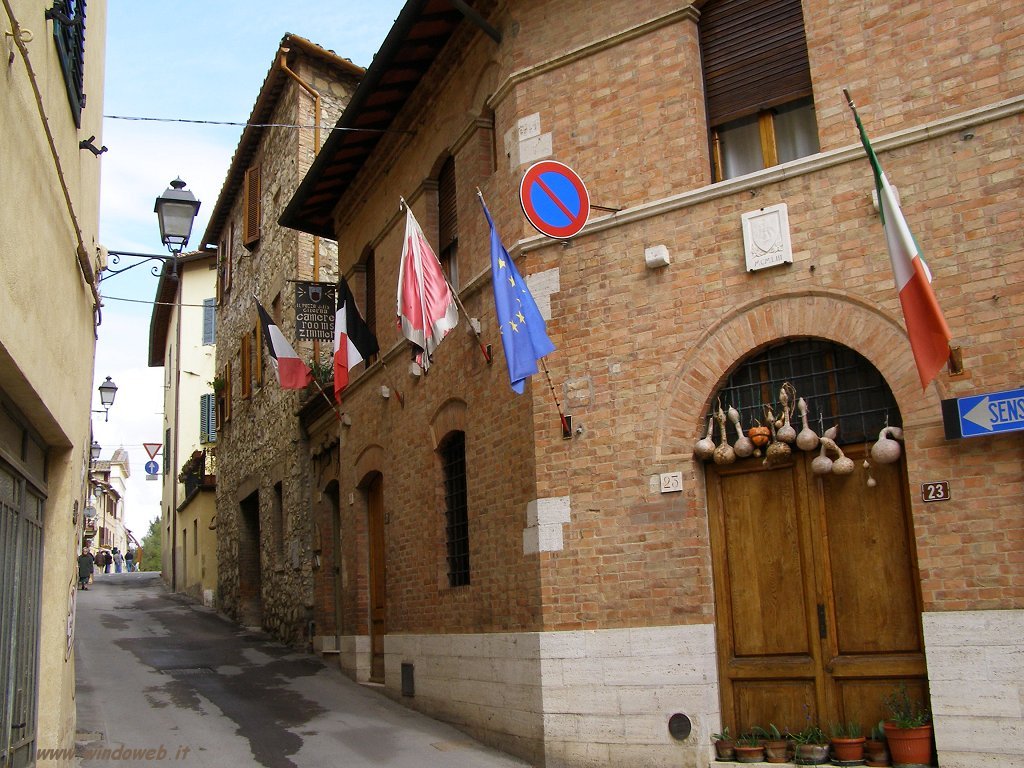Berardenga: una farfalla dalle grandi aliBerardenga: a butterfly with large wings
 Incastonato tra le colline del Chianti e il paesaggio delle crete senesi; il territorio di Castelnuovo Berardenga circonda la città di Siena a nord e ad est.
Incastonato tra le colline del Chianti e il paesaggio delle crete senesi; il territorio di Castelnuovo Berardenga circonda la città di Siena a nord e ad est.
La sua delimitazione amministrativa è molto antica: già nella seconda metà del Cinquecento, la Podesteria di Castelnuovo Berardenga, occupava un territorio corrispondente a quello attuale. Una strozzatura geografica – tra i confini di Gaiole in Chianti e Siena – dove è Pianella, lo divide in due parti simili a grandi ali di farfalla. Quella ad ovest comprende Vagliagli, Pieve Asciata, Quercegrossa, Pontignano e Bozzone; quella a sud-est, oltre al capoluogo, San Gusmè, Badia d’Ombrone, Villa a Sesta e Monteaperti.
Il paesaggio è quello collinare che separa la parte iniziale della valle dell’Ombrone da quella del suo affluente Arbia. Arbia e Ombrone sono quindi i fiumi principali che solcano il territorio, ma se l’Arbia non ha bisogno di presentazioni, essendo il suo nome trascritto dalla penna nientepopodimenochè di Dante, l’Ombrone chiede alla nostra fantasia di immaginarvi riflessi e chini a bere nelle sue acque; gli Etruschi che adesso dormono sulle colline di Campi.
Territorio di antico insediamento, la Berardenga prende il suo nome dal nobile Berardo di stirpe franca, vissuto nel X secolo e discendente di Guinigi da Lucca che, tra l’867 e l’881, era stato conte di Siena. La storia della famiglia fondatrice si trova ampliamente documentata nel ricco corpus detto “Cartulario della Berardenga”.
Fin dalla metà del XII secolo, Siena cominciò a esercitare un sempre più stretto controllo sul territorio. Un secolo dopo, la maggior parte dei castelli berardenghi, erano sotto l’amministrazione senese.
Il capoluogo sorse nel XIV secolo, in un località denominata “Poggio ai Frati”. Numerose chiesette romaniche, sparse un po’ ovunque, ricordano il grande sviluppo economico e demografico registrato nel XII e XIII secolo. Uno dei fatti che più colpisce del territorio di Castelnuovo Berardenga dell’epoca medioevale, è il numero elevatissimo di castelli. Ma le testimonianze abitative del medioevo non si limitano soltanto alle Chiese e ai castelli perché, accanto a queste costruzioni di impianto o guerresco o religioso; sorsero ville fortificate e case signorili che annunciavano l’avvento del rinascimento.
San Gusmè, Vagliagli, Quercegrossa, Monteaperti, Guistrigona, San Giovanni a Cerreto, Pieve Asciata, Rosennano, Villa a Sesta, Vitignano, il fiume Arbia, l’Ombrone, le tombe etrusche di Campi e cosi’ via sono alcuni dei luoghi da non perdere. Nella Berardenga geografia e storia sono strettamente unite, si intrecciano nei luoghi e negli eventi che non tralascerete dalle vostre escursioni. Set between the hills of Chianti and the landscape of the Sienese Xanax Online “crete”, Castelnuovo Berardenga surrounds the city of Siena to the North and the East. Its administrative boundary is very old: already in the second half of the sixteenth century, the “Podesteria” of Castelnuovo Berardenga occupied an area similar to that of today. A geographical bottleneck – between the border of Gaiole in Chianti and Siena – where Pianella now lies, divides it into two parts similar to large butterfly’s wings. The one to the West comprises Vagliagli, Pieve Asciata, Quercegrossa, Pontignano and Bozzone while the one to the South-east comprises the capital, San Gusmè, Badia d’Ombrone, Villa a Sesta and Monteaperti.
Set between the hills of Chianti and the landscape of the Sienese Xanax Online “crete”, Castelnuovo Berardenga surrounds the city of Siena to the North and the East. Its administrative boundary is very old: already in the second half of the sixteenth century, the “Podesteria” of Castelnuovo Berardenga occupied an area similar to that of today. A geographical bottleneck – between the border of Gaiole in Chianti and Siena – where Pianella now lies, divides it into two parts similar to large butterfly’s wings. The one to the West comprises Vagliagli, Pieve Asciata, Quercegrossa, Pontignano and Bozzone while the one to the South-east comprises the capital, San Gusmè, Badia d’Ombrone, Villa a Sesta and Monteaperti.
The hilly terrain separates the upper part of the Ombrone valley from that of its tributary, the Arbia. The Arbia and the Ombrone are therefore the main rivers in the area, but while the Arbia needs no presentation, as its name has even been written by the pen of Dante, the Ombrone asks us to imagine the Etruscans, that now sleep in the hills of Campi, lying down and drinking from its waters.
A land of ancient settlements, Berardenga takes its name from the noble Frankish family, Berardo, which lived in the tenth century and descended from Guinigi da Lucca who, between 867 and 881, had been count of Siena. The history of the founding family is fully documented in the rich corpus known as the “Cartulario della Berardenga”.
Since the mid-twelfth century, Siena began to exercise increasingly tighter control on the area. A century later, most of the castles in the area were controlled by Siena.
In the fourteenth century, the capital was built in an area called “Poggio ai Frati”. Numerous Romanesque churches, scattered more or less everywhere, remind us of the great economic and population explosion in the twelfth and thirteenth centuries. One of the most striking facts about the territory of Castelnuovo Berardenga in medieval times is the large number of castles. But the medieval building are not only churches and castles as, along with these military and religious constructions there also were fortified villas and mansions that announced the coming of the Renaissance.
San Gusmè, Vagliagli, Quercegrossa, Monteaperti, Guistrigona, San Giovanni a Cerreto, Pieve Asciata, Rosennano, Villa a Sesta, Vitignano, the Arbia, the Ombrone, the Etruscan tombs of Campi and so on, are some of the places that are not to be missed. In Berardenga, geography and history are closely connected, they intertwine in the events and the places that you will not fail to visit during your excursions.

